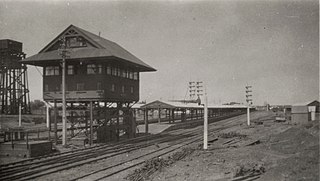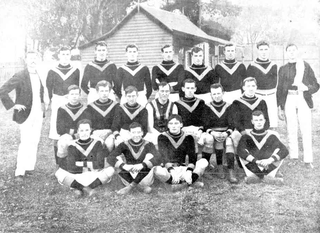Related Research Articles

Albert Watson Newton was an Australian media personality. He was a Logie Hall of Fame inductee, quadruple Gold Logie award-winning entertainer, and radio, theatre, and television personality and compere.

Whitsunday Island is the largest island in the Whitsunday group of islands located off the coast of Central Queensland, Australia.

Civil disturbances in Western Australia include race riots, prison riots, and religious conflicts – often Protestant versus Catholic groups.

John Mackay was a Scottish-born explorer, sailor and harbourmaster best known for having the town of Mackay, Queensland named after him.

Harold Pierce Cazneaux, commonly referred to as H. P. Cazneaux, was an Australian photographer; a pioneer whose style had an indelible impact on Australian photographic history. In 1916, he was a founding member of the pictorialist Sydney Camera Circle. As a regular participator in national and international exhibitions, Cazneaux was unfaltering in his desire to contribute to the discussion about the photography of his times. His career between the Wars established him as "the country's leading pictorial photographer".

Australian native police were specialised mounted military units consisting of detachments of Aboriginal troopers under the command of White officers appointed by colonial governments. These units existed in various forms in colonial Australia during the nineteenth and, in some cases, into the twentieth centuries. From temporary base camps and barracks, Native Police were primarily used to patrol the often vast geographical areas along the colonial frontier in order to conduct indiscriminate raids and punitive expeditions against Aboriginal people. The Native Police proved to be a brutally destructive instrument in the disintegration and dispossession of Indigenous Australians. Armed with rifles, carbines and swords, they were also deployed to escort surveying groups, gold convoys and groups of pastoralists and prospectors.
John Philip Bourke was an Australian poet.

Kalgoorlie railway station is the easternmost attended station in Western Australia, located at the eastern terminus of the Eastern Goldfields Railway. It serves the city of Kalgoorlie. Beyond Kalgoorlie, the line continues east as the Trans-Australian Railway.

Leo Malachi "Sammy" Seward was an all-round athlete, who played Australian rules football with University in the Victorian Football League (VFL) where he was regarded by his fellow players as one of the cleverest followers.
Arthur Wright was an Australian writer best known for his novels set against a background of the sporting world, particularly horseracing, which meant he was often compared during his lifetime to Nat Gould. In his lifetime he was called "Australia's most prolific novelist".
State Batteries in Western Australia were government owned and run ore-crushing facilities for the gold mining industry. Western Australia was the only Australian state to provide batteries to assist gold prospectors and small mines. They existed in almost all of the mineral fields of Western Australia.
Lamarck Island may refer to:
Wentworth D'Arcy Uhr was an officer in the paramilitary Native Police in the British colony of Queensland. After being demoted for poor conduct, he resigned from this force and became a drover, leading the first herds of cattle into the region now known as the Northern Territory. He later became, amongst other vocations, a gold prospector, butcher and hotelier. Throughout his life, Uhr actively engaged in multiple incidents of frontier violence including several massacres of Aboriginals. He was also the subject of numerous court cases defending charges which ranged from murder and assault to race-fixing and fraud. In later life he moved to Western Australia and became a business partner with Charles Kidman, brother of the famous pastoralist, Sidney Kidman.

Andrew Oswald Wilson (1866–1950), known professionally as A. Oswald Wilson, was an early-20th-century Western Australian architect. Born and trained as a carpenter in Victoria, he moved first to Perth and then to the Eastern Goldfields, where he worked for Murdock McKay Hopkins. He was president of the Mechanics' Literary and Debating Society in Boulder from 1904 to 1908, as well as active in the Boulder Benevolent Society. One of his best-known buildings is the Boulder town hall for which he submitted designs in 1907. In December 1908, he moved back to Perth and practised from Forrest Chambers.

George Dinnie was a sportsman, strongman, wrestler and champion dog breeder. For a while, he was part of the travelling show promoted by Henry Jasper Redfern in Sheffield, England, and often billed as the "strongest man on earth".

Edric Norfolk Vaux Morisset was a high-ranking officer in both the paramilitary and civilian police forces of the New South Wales and Queensland colonies of the British Empire. He was Commandant of the paramilitary Native Police from 1857 to 1861 and concurrently became the first Inspector General of Police in Queensland in 1860. Morisset afterwards was appointed Superintendent of Police at Bathurst and then later on at Maitland. From 1883 until his death in 1887, Morisset was Superintendent of the Southern Districts and Deputy Inspector General of Police in New South Wales.

Alexander McKenzie was an Australian rules footballer for Port Adelaide. He was noted to be able to kick a football 75 yards without the assistance of wind.

Arthur Maybee Chanter (1866-1950) was an Australian composer, conductor, music teacher, choir master and musician. An accomplished pianist and watercolorist, Chanter was among the earliest music graduates of the University of Melbourne, where he was instructed by George Marshall-Hall. In 1910 Chanter was the adjudicator of a musical Eistedfodd and band competition of an association of native-born Australians in Western Australia. He married Josephine in 1902 but divorced her in 1914, taking another wife Sara Kate Campbell in 1915. He live mostly in Brighton, Victoria and Elsternwick, but was well travelled. He advocated recording as a means to reach the working clubs and masses and was damning of the teaching methods in public schools. He retired to Euroa and died 28 November 1950, and is buried in Cheltenhan pioneer cemetery.

The Town of Kalgoorlie was a local government area in Western Australia, centred on the town of Kalgoorlie.
References
- ↑ Gazetteer of Australia (1996). Belconnen, ACT: Australian Surveying and Land Information Group.
- ↑ "Place names of Australia". Geoscience Australia. 2004.
- ↑ "NORTH-WEST TRAGEDY". Sunday Times . No. 873. Perth. 27 September 1914. p. 10. Retrieved 13 May 2024– via National Library of Australia.
- ↑ "A NATIVE TRIBE'S REVENGE". Huon Times . Vol. 3, no. 466. Franklin. 3 October 1914. p. 6. Retrieved 13 May 2024– via National Library of Australia.
- ↑ "HANOVER BAY MURDERS". Kalgoorlie Western Argus . Vol. 20, no. 4880. Kalgoorlie. 29 September 1914. p. 7. Retrieved 13 May 2024– via National Library of Australia.
- ↑ "UNCONQUERED AUSTRALIA". Barrier Miner . Vol. XXVII, no. 8160. Broken Hill. 10 October 1914. p. 2. Retrieved 13 May 2024– via National Library of Australia.